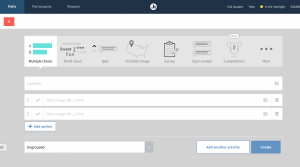If you have ever thought about adding more interaction into your lectures, audience response systems (ARS) are easier than ever to use and a great tool for moving students beyond passive listening and note-taking. Most current platforms allow students to use their smartphone instead of special tools like clickers just by downloading an app to their phone or through a URL on their laptop or tablet. ARS platforms today use web-based software to gather, tabulate and post response data, as audience members (or students) respond to a lecturer’s questions in real time. ARS platforms also allow lecturers to collect feedback and use it for a variety of purposes including tracking individual responses, discovering misconceptions, and analyzing the audience’s understanding of content.
How Audience Response Systems Enhance Teaching & Learning
Using an ARS has a list of benefits it can bring to face-to-face classrooms, especially in courses where teaching a large group of students impacts the kinds of conversations you can have. ARS’s provide for a more active learning environment and allows lecturers to assess if students understood what was presented in class, providing immediate formative feedback and explicitly underscoring the key points in the lecture.
Research on ARS use has shown that it is successful in harnessing the “testing effect.” The testing effect has found that long-term memory is often increased when some of the learning time is devoted to retrieving the information just learned. In addition, ARS also gives instructors a chance to collect relevant data and review analytics for their classes, as well as refine their questions based on responses.
ARS can also add engagement and an element of fun to a lecture. Some ARS’s allow for competitions, teams, timed responses and the display of points earned. These features bring the unique features of gaming into the class environment and provide a way to connect with students raised in a digital world where interactivity is not only more ubiquitous than for previous generations of students but is an expectation, too.
Implementation in Emory School of Medicine and Rollins School of Public Health
Here at Emory University, both the School of Medicine and the Rollins School of Public Health have added ARS subscription accounts and made them available to faculty. The School of Medicine went through a lengthy review process of different ARS technologies to understand what might work best and settled on implementing Poll Everywhere, as well as the simpler but effective platform, Kahoot!.

A screenshot from Poll Everywhere that displays question types on a poll creation page.
- Poll Everywhere had one of the more straightforward interfaces of all the platforms reviewed and provides a rich set of choices in question types. Students can mark specific places on images by clicking on them, answer a variety of multiple-choice question types, respond to rank-order questions, and enter responses for open-ended questions that display word clouds that visually reflect the number of responses per answer choice. Poll Everywhere also allows an instructor to embed a slide on a web page or in a Canvas course page and collect responses over a period of time. A free version is available for classes up to 40 students (though not all features are available in the free version).
- Kahoot!, while offering fewer question types and pared-down features, is free (even for larger classes) and has a small learning curve. It’s perfect for a quick review of the key information presented in a lecture and creating engaging learning experiences even with serious, complex topics without a huge time investment from the instructor.
Both platforms also allow for homework assignments where the instructor assigns open and close dates and times to a question or set of questions.
To learn more about ARS at Emory, get help on implementing these tools, and more, check out the Teaching and Learning Technologies guide to ARS.
